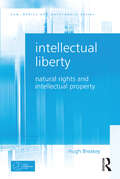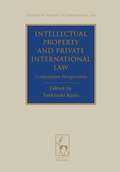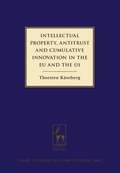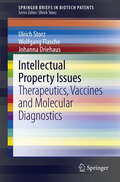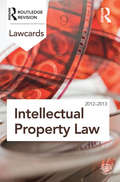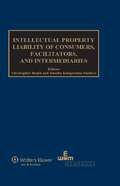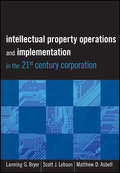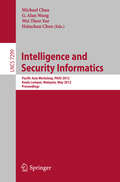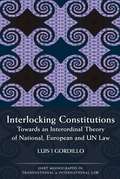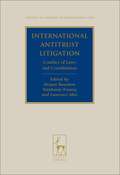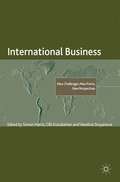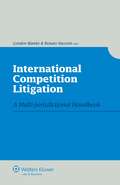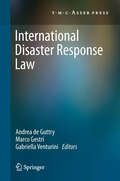- Table View
- List View
Intellectual Liberty: Natural Rights and Intellectual Property
by Hugh BreakeyConsidering the steady increase in intellectual property rights in the last century, does it make sense to speak of ’user’s rights’ and can limitations on intellectual liberty be justified from a rights-based perspective? This book philosophically defends the importance of the public domain and user’s rights through the use of natural-rights thought. Utilizing primarily the work of John Locke, it contends that considerations of natural justice and human freedom impose powerful constraints on the proper reach and substance of intellectual property rights, especially copyright. It investigates both the internal and external natural-rights constraints on intellectual property, and argues in particular for the importance to human freedom of the right to intellectual liberty - the right to inform one’s actions by learning about the world. It concludes that respect for fundamental freedom-based interests require a balanced approach to the scope, strength and duration of intellectual property rights.
Intellectual Liberty: Natural Rights and Intellectual Property
by Hugh BreakeyConsidering the steady increase in intellectual property rights in the last century, does it make sense to speak of ’user’s rights’ and can limitations on intellectual liberty be justified from a rights-based perspective? This book philosophically defends the importance of the public domain and user’s rights through the use of natural-rights thought. Utilizing primarily the work of John Locke, it contends that considerations of natural justice and human freedom impose powerful constraints on the proper reach and substance of intellectual property rights, especially copyright. It investigates both the internal and external natural-rights constraints on intellectual property, and argues in particular for the importance to human freedom of the right to intellectual liberty - the right to inform one’s actions by learning about the world. It concludes that respect for fundamental freedom-based interests require a balanced approach to the scope, strength and duration of intellectual property rights.
Intellectual Property and Biodiversity: Rights to Animal Genetic Resources
by Michelangelo TemmermanBiotechnology is at the heart of heated debates about ethics, safety, economic development, and about the control over the biological materials and technologies used. The latter, grossly called biodiversity issues relating to the application of intellectual property, has been the subject of a wealth of literature. Yet, the situation of animal genetic resources specifically has only marginally been addressed so far. Many books and articles address ‘biotechnology and agriculture’, but have only plants and seeds in mind. Case-law and specific regulation is equally scarce. Exacerbated by the so-called ‘erosion of animal genetic resources’, climate change, the globalization of the market-place, and a strong concentration of markets, animal genetic resources however demand specific analysis and adjustments in intellectual property law. The decoupling of rights over animal genetic resources as an abstract concept, from those over the concrete animals is a fact today. The application of patents in this context became a full-fledged part of the management of animal genetic resources. This monograph analyzes against this background the impact of the patent system on ownership traditions in agriculture, on animal welfare, and on biodiversity. It looks at how those factors in turn are likely to affect the shape of patent law, and how they should affect it. The author hereby focuses on important specific issues arising, including the following: the underlying elements deciding on the shape of regulation – innovation, economic development, agriculture, human rights, animal welfare, the conservation of resources, and equal trading conditions; the continuing applicability of trademarks, geographical indications, copyright, and trade secrets; patentability rules and exclusions; the extension of patent rights over progeny; the meaning of ‘essentially biotechnological processes’; the legal definitions of ‘morality’ and ‘ordre public’ in the context of animal welfare; and the future of international patent law in the context of global governance theories. With detailed investigation of how three major jurisdictions – the European Union, the United States, and Canada – have regulated the matter, the book highlights unresolved issues in the laws dealing with animal genetic resources. How do the usual principles of patent law affect ownership over animals in agriculture? To what extent is patent law in accordance with neighbouring fields of regulation, with relation to animal welfare? How can intellectual property be used to alter, stimulate, or tackle developments in the realm of the conservation and promotion of biodiversity? Questions like these are asked, checked upon the more technical country studies; and then used to put to test the adequacy of international patent regulation in a final chapter. As a deeply informed overview of the arguments and discussion points, this is the only book of its kind. It links general discussions to the often technical and complicated patent regulations, in the specific context of animal genetic resources. It is sure to bring lawyers in the field closer to the policy debates; and decision makers closer to the precise idiosyncrasies of patent law.
Intellectual Property And Emerging Technologies: The New Biology (Queen Mary Studies In Intellectual Property Ser. (PDF))
by Matthew Rimmer Alison McLennanThis unique and comprehensive collection investigates the challenges posed to intellectual property by recent paradigm shifts in biology. It explores the legal ramifications of emerging technologies, such as genomics, synthetic biology, stem cell research, nanotechnology, and biodiscovery. Extensive contributions examine recent controversial court decisions in patent law - such as Bilski v. Kappos, and the litigation over Myriad's patents in respect of BRCA1 and BRCA2 - while other papers explore sui generis fields, such as access to genetic resources, plant breeders' rights, and traditional knowledge. The collection considers the potential and the risks of the new biology for global challenges - such as access to health-care, the protection of the environment and biodiversity, climate change, and food security. It also considers Big Science projects - such as biobanks, the 1000 Genomes Project, and the Doomsday Vault. The inter-disciplinary research brings together the work of scholars from Australia, Canada, Europe, the UK, and the US and involves not only legal analysis of case law and policy developments, but also historical, comparative, sociological, and ethical methodologies. Intellectual Property and Emerging Technologies will appeal to policy-makers, legal practitioners, business managers, inventors, scientists, and researchers.
Intellectual Property and Private International Law: Comparative Perspectives (Studies in Private International Law)
by Toshiyuki Kono'Intellectual property and private international law' was one of the subjects discussed at the 18th International Congress of Comparative Law held in Washington (July 2010). This volume contains the General Report and 20 National Reports covering Canada, US, Japan, Korea, India and a number of European countries (Austria, France, Germany, UK, Spain etc). The General Report was prepared on the basis of National Reports. The national reporters not only describe the existing legal framework, but also provide answers for up to 12 hypothetical cases concerning international jurisdiction, choice-of-law and recognition and enforcement of foreign judgments in multi-state IP disputes. Based on their answers the main differences between legal systems as well as the shortcomings of the cross-border enforcement of IP rights are outlined in the General Report. The Reports in this volume analyse relevant court decisions as well as recent legislative proposals (such as the ALI, CLIP, Transparency, Waseda and Korean Principles). This book is therefore a significant contribution to the existing debate in the field and will be a valuable source of reference in shaping future developments in the cross-border enforcement of IP rights in a global context.
Intellectual Property and Private International Law: Comparative Perspectives (Studies in Private International Law #10)
by Toshiyuki Kono'Intellectual property and private international law' was one of the subjects discussed at the 18th International Congress of Comparative Law held in Washington (July 2010). This volume contains the General Report and 20 National Reports covering Canada, US, Japan, Korea, India and a number of European countries (Austria, France, Germany, UK, Spain etc). The General Report was prepared on the basis of National Reports. The national reporters not only describe the existing legal framework, but also provide answers for up to 12 hypothetical cases concerning international jurisdiction, choice-of-law and recognition and enforcement of foreign judgments in multi-state IP disputes. Based on their answers the main differences between legal systems as well as the shortcomings of the cross-border enforcement of IP rights are outlined in the General Report. The Reports in this volume analyse relevant court decisions as well as recent legislative proposals (such as the ALI, CLIP, Transparency, Waseda and Korean Principles). This book is therefore a significant contribution to the existing debate in the field and will be a valuable source of reference in shaping future developments in the cross-border enforcement of IP rights in a global context.
Intellectual Property, Antitrust and Cumulative Innovation in the EU and the US (Hart Studies in Competition Law)
by Thorsten KäsebergFor decades, the debate about the tension between IP and antitrust law has revolved around the question to what extent antitrust should accept that IP laws may bar competition in order to stimulate innovation. The rise of IP rights in recent years has highlighted the problem that IP may also impede innovation, if research for new technologies or the marketing of new products requires access to protected prior innovation. How this 'cumulative innovation' is actually accounted for under IP and antitrust laws in the EU and the US, and how it could alternatively be dealt with, are the central questions addressed in this unique study by lawyer and economist Thorsten Käseberg.Taking an integrated view of both IP and antitrust rules – in particular on refusals to deal based on IP – the book assesses policy levers under European and US patent, copyright and trade secrecy laws, such as the bar for and scope of protection as well as research exemptions, compulsory licensing regimes and misuse doctrines. It analyses what the allocation of tasks is and should be between these IP levers and antitrust rules, in particular the law on abuse of dominance (Article 102 TFEU) and monopolisation (Section 2 Sherman Act), while particular attention is paid to the essential facilities doctrine, including pricing methodologies for access to IP.Many recent decisions and judgments are put into a coherent analytical framework, such as IMS Health, AstraZeneca, GlaxoSmithKline (in the EU), Apple (France), Orange Book Standard (Germany), Trinko, Rambus, NYMEX, eBay (US), Microsoft and IBM/T3 (both EU and US). Further topics covered include: IP protection for software, interoperability information and databases; industry-specific tailoring of IP; antitrust innovation market analysis; and the WTO law on the IP/antitrust interface.
Intellectual Property Issues: Therapeutics, Vaccines and Molecular Diagnostics (SpringerBriefs in Biotech Patents)
by Ulrich Storz Wolfgang Flasche Johanna DriehausSpringerBriefs in Biotech Patents present timely reports of intellectual properties (IP) issues and patent aspects in the field of biotechnology. This new volume in the series focuses on the particular IP issues of therapeutics, vaccines and molecular diagnostics. The first chapter concentrates on basics principles for protecting antibody compounds. Additional ways to create follow-up protection for antibody therapeutics are also discussed. The second chapter gives an overview of the patent landscape in molecular diagnostics, and discusses issues of patentability with respect to the different technologies and compounds used therein. The third chapter gives a broad overview of areas of law that are particularly relevant to the patenting of peptide vaccines and therapeutic peptides as products and in compositions. The scope of patentable subject matter is discussed, as it has been the focus of much wrangling and debate in the courts.
Intellectual Property Law and History
by Steven WilfIntellectual property has become a dominant feature of our knowledge based economy in recent years, but how has property rights in intangible items developed? This book brings together for the first time exemplary scholarship with diverse approaches to the history of United States intellectual property protection, including trade secrets, trademark, copyright, and patent law. These articles, written by leading experts in the field and often challenging conventional narratives, underscore the importance of historical perspectives for understanding how an extensive, evolving framework for the regulation of knowledge emerged in the modern period. By tracing intellectual property from an historical perspective - not merely providing justifications in philosophy or economics in the abstract - this book draws upon the past to address contemporary debates over such varied topics as: access to knowledge; policing copyright infringement; whether employees should own the products of their minds; the role of national borders in an age of digital information; and the very future of intellectual property as stakeholders and consumers contest the extent of its legal protection.
Intellectual Property Law and History
by Steven WilfIntellectual property has become a dominant feature of our knowledge based economy in recent years, but how has property rights in intangible items developed? This book brings together for the first time exemplary scholarship with diverse approaches to the history of United States intellectual property protection, including trade secrets, trademark, copyright, and patent law. These articles, written by leading experts in the field and often challenging conventional narratives, underscore the importance of historical perspectives for understanding how an extensive, evolving framework for the regulation of knowledge emerged in the modern period. By tracing intellectual property from an historical perspective - not merely providing justifications in philosophy or economics in the abstract - this book draws upon the past to address contemporary debates over such varied topics as: access to knowledge; policing copyright infringement; whether employees should own the products of their minds; the role of national borders in an age of digital information; and the very future of intellectual property as stakeholders and consumers contest the extent of its legal protection.
Intellectual Property Lawcards 2012-2013 (Lawcards)
by RoutledgeRoutledge Lawcards are your complete, pocket-sized guides to key examinable areas of the undergraduate law curriculum and the CPE/GDL. Their concise text, user-friendly layout and compact format make them an ideal revision aid. Helping you to identify, understand and commit to memory the salient points of each area of the law, shouldn’t you make Routledge Lawcards your essential revision companions? Fully updated and revised with all the most important recent legal developments, Routledge Lawcards are packed with features: Revision checklists help you to consolidate the key issues within each topic Colour coded highlighting really makes cases and legislation stand out Full tables of cases and legislation make for easy reference Boxed case notes pick out the cases that are most likely to come up in exams Diagrams and flowcharts clarify and condense complex and important topics '...an excellent starting point for any enthusiastic reviser. The books are concise and get right down to the nitty-gritty of each topic.' - Lex Magazine Routledge Lawcards are supported by a Companion Website offering: Flashcard glossaries allowing you to test your understanding of key terms and definitions Multiple Choice Questions to test and consolidate your revision of each chapter Advice and tips to help you better plan your revision and prepare for your exams Titles in the Series: Commercial Law; Company Law; Constitutional Law; Contract Law; Criminal Law; Employment Law; English Legal System; European Union Law; Evidence; Equity and Trusts; Family Law; Human Rights; Intellectual Property Law; Jurisprudence; Land Law; Tort Law
Intellectual Property Lawcards 2012-2013 (Lawcards)
by RoutledgeRoutledge Lawcards are your complete, pocket-sized guides to key examinable areas of the undergraduate law curriculum and the CPE/GDL. Their concise text, user-friendly layout and compact format make them an ideal revision aid. Helping you to identify, understand and commit to memory the salient points of each area of the law, shouldn’t you make Routledge Lawcards your essential revision companions? Fully updated and revised with all the most important recent legal developments, Routledge Lawcards are packed with features: Revision checklists help you to consolidate the key issues within each topic Colour coded highlighting really makes cases and legislation stand out Full tables of cases and legislation make for easy reference Boxed case notes pick out the cases that are most likely to come up in exams Diagrams and flowcharts clarify and condense complex and important topics '...an excellent starting point for any enthusiastic reviser. The books are concise and get right down to the nitty-gritty of each topic.' - Lex Magazine Routledge Lawcards are supported by a Companion Website offering: Flashcard glossaries allowing you to test your understanding of key terms and definitions Multiple Choice Questions to test and consolidate your revision of each chapter Advice and tips to help you better plan your revision and prepare for your exams Titles in the Series: Commercial Law; Company Law; Constitutional Law; Contract Law; Criminal Law; Employment Law; English Legal System; European Union Law; Evidence; Equity and Trusts; Family Law; Human Rights; Intellectual Property Law; Jurisprudence; Land Law; Tort Law
Intellectual Property Liability of Consumers, Facilitators and Intermediaries
by Christopher Heath Anselm Kamperman SandersWith reports from all major jurisdictions where the responsibility of facilitators and intermediaries for copyright and trade mark infringement have been litigated, this very useful book is the first comprehensive global survey of the liability regime that intermediaries may face when assisting others to directly infringe copyright and trade mark rights, or when providing others with the means to do so. It addresses such issues as the following: ISP liability; contributory and secondary liability for trade mark, copyright, and patent infringement; time- and geo-shifting devices and services; consumer identification through dynamic IP addresses; infringements committed on a “commercial scale”; liability of hosting providers; requirements for a breach of duty of care; notice to users to refrain from infringements; filters and other due diligence measures; “actual knowledge”; privacy and infringers’ personal data; file sharing services; online storage services; and liability of transporters and freighters. After a general introduction analysing relevant aspects of trade mark and copyright law, local experts provide detailed reports on positions in the EU (at the Community level), Germany, France, Italy, The United States, Japan, Korea, Australia, and New Zealand. As well as dealing with the issues, each report pays close attention to case law, legislative developments, and procedural issues of injunctive relief and damages. A final chapter covers comparative contributory patent infringement. Along with the very practical value the book offers corporate counsel charged with IP rights litigation, the authors shed light on the fundamental issue of whether attempts to broaden liability in this area are compatible with established IP principles such as territoriality, freedom to operate, and freedom of competition. As a result, the book will be welcomed by a wide spectrum of lawyers and others working in this rapidly growing field, including practitioners, policymakers, academics, and jurists.
Intellectual Property Operations and Implementation in the 21st Century Corporation
by Lanning G. Bryer Scott J. Lebson Matthew D. AsbellA practical approach to corporate IP operations and implementation Intellectual Property Operations and Implementation helps executives, attorneys, accountants, managers, and owners, understand the legal, technological, economic, and cultural changes that have affected corporate IP ownership and management. Page by page, it provides practical examples and advice from seasoned and enduring professionals who have adopted new and streamlined methods and practices whether as in-house or outside counsel, or service providers. Timely and relevant in view of the substantially global economic recession amidst rampant technological development and the resulting changes in law, practice, and culture Examines the decision making processes, activities, and changes of significant corporate intellectual property owners in today's new economy Important and timely, this book provides a global approach to corporate IP management.
Intellectual Property Operations and Implementation in the 21st Century Corporation
by Lanning G. Bryer Scott J. Lebson Matthew D. AsbellA practical approach to corporate IP operations and implementation Intellectual Property Operations and Implementation helps executives, attorneys, accountants, managers, and owners, understand the legal, technological, economic, and cultural changes that have affected corporate IP ownership and management. Page by page, it provides practical examples and advice from seasoned and enduring professionals who have adopted new and streamlined methods and practices whether as in-house or outside counsel, or service providers. Timely and relevant in view of the substantially global economic recession amidst rampant technological development and the resulting changes in law, practice, and culture Examines the decision making processes, activities, and changes of significant corporate intellectual property owners in today's new economy Important and timely, this book provides a global approach to corporate IP management.
Intelligence and Security Informatics: Pacific Asia Workshop, PAISI 2012, Kuala Lumpur, Malaysia, May 29, 2012, Proceedings (Lecture Notes in Computer Science #7299)
by Michael Chau Wei Thoo Yue G. Alan Wang Hsinchun ChenThis book constitutes the refereed proceedings of the Pacific Asia Workshop on Intelligence and Security Informatics, PAISI 2012, held in Kuala Lumpur, Malaysia, in May 2012 - held in conjunction with the Pacific Asia Conference on Knowledge Discovery and Data Mining (PAKDD 2012). The 8 revised full papers and the 8 revised short papers presented together with 1 keynote lecture were carefully reviewed and selected from numerous submissions. The papers are organized in topical sections on terrorism informatics and crime analysis, social media, intrusion detection, data and text mining, as well as information access and security.
Interlocking Constitutions: Towards an Interordinal Theory of National, European and UN Law (Hart Monographs in Transnational and International Law)
by Luis I GordilloThe existence of interactions between different but overlapping legal systems has always presented challenges to black letter law. This is particularly true of the relationship between international law and domestic law and the relationship between federal law and the laws of individual federation members. Moreover some organisations have created their own supranational constitutional systems: the United Nations Charter is the best known, and is often referred to as the 'World Constitution', but the European Court of Justice in Luxembourg views the European Treaties as a 'Constitutional Charter' for Europe, while the European Court of Human Rights has defined the European Convention on Human Rights as a constitutional instrument of 'European public order'. It is in the dynamic relationship between domestic constitutional laws, EU law, the ECHR and the UN Charter that the most persistent difficulties arise. In this context 'interordinal instability' not only provokes strong academic interest, but also affects what has been called 'governance' or 'global government' and undermines both legal certainty and individual fundamental rights. Different solutions - constitutionalist and pluralist - have been explored, but none of them has received global acceptance. In this book Luis Gordillo analyses the interordinal instabilities which arise at the European level, focusing on three main strands of case law and their implications: Solange, Bosphorus and Kadi. To solve the difficulties caused by this instability Gordillo proposes a form of soft constitutionalism, which he calls 'interordinal constitutionalism', as a means to bring order and stability to global legal governance.The original Spanish thesis on which this book is based was awarded the Nicolás Pérez Serrano Prize by the Centro de Estudios Políticos y Constitucionales, for the best dissertation in constitutional law 2009-2010.
Interlocking Constitutions: Towards an Interordinal Theory of National, European and UN Law (Hart Monographs in Transnational and International Law #8)
by Luis I GordilloThe existence of interactions between different but overlapping legal systems has always presented challenges to black letter law. This is particularly true of the relationship between international law and domestic law and the relationship between federal law and the laws of individual federation members. Moreover some organisations have created their own supranational constitutional systems: the United Nations Charter is the best known, and is often referred to as the 'World Constitution', but the European Court of Justice in Luxembourg views the European Treaties as a 'Constitutional Charter' for Europe, while the European Court of Human Rights has defined the European Convention on Human Rights as a constitutional instrument of 'European public order'. It is in the dynamic relationship between domestic constitutional laws, EU law, the ECHR and the UN Charter that the most persistent difficulties arise. In this context 'interordinal instability' not only provokes strong academic interest, but also affects what has been called 'governance' or 'global government' and undermines both legal certainty and individual fundamental rights. Different solutions - constitutionalist and pluralist - have been explored, but none of them has received global acceptance. In this book Luis Gordillo analyses the interordinal instabilities which arise at the European level, focusing on three main strands of case law and their implications: Solange, Bosphorus and Kadi. To solve the difficulties caused by this instability Gordillo proposes a form of soft constitutionalism, which he calls 'interordinal constitutionalism', as a means to bring order and stability to global legal governance.The original Spanish thesis on which this book is based was awarded the Nicolás Pérez Serrano Prize by the Centro de Estudios Políticos y Constitucionales, for the best dissertation in constitutional law 2009-2010.
International Antitrust Litigation: Conflict of Laws and Coordination (Studies in Private International Law)
by Jurgen Basedow Stephanie Francq Laurence IdotThe decentralisation of competition law enforcement and the stimulation of private damages actions in the European Union go hand in hand with the increasingly international character of antitrust proceedings. As a consequence, there is an ever-growing need for clear and workable rules to co-ordinate cross-border actions, whether they are of a judicial or administrative nature: rules on jurisdiction, applicable law and recognition as well as rules on sharing of evidence, the protection of business secrets and the interplay between administrative and judicial procedures. This book offers an in-depth analysis of these long neglected yet practically most important topics. It is the fruit of a research project funded by the European Commission, which brought together experts from academia, private practice and policy-making from across Europe and the United States. The 16 chapters cover the relevant provisions of the Brussels I and Rome I and II Regulations, the co-operation mechanisms provided for by Regulation 1/2003 and selected issues of US procedural law (such as discovery) that are highly relevant for transatlantic damages actions. Each contribution critically analyses the existing legislative framework and formulates specific proposals to consolidate and enhance cross-border antitrust litigation in Europe and beyond.
International Antitrust Litigation: Conflict of Laws and Coordination (Studies in Private International Law #8)
by Jurgen Basedow Stephanie Francq Laurence IdotThe decentralisation of competition law enforcement and the stimulation of private damages actions in the European Union go hand in hand with the increasingly international character of antitrust proceedings. As a consequence, there is an ever-growing need for clear and workable rules to co-ordinate cross-border actions, whether they are of a judicial or administrative nature: rules on jurisdiction, applicable law and recognition as well as rules on sharing of evidence, the protection of business secrets and the interplay between administrative and judicial procedures. This book offers an in-depth analysis of these long neglected yet practically most important topics. It is the fruit of a research project funded by the European Commission, which brought together experts from academia, private practice and policy-making from across Europe and the United States. The 16 chapters cover the relevant provisions of the Brussels I and Rome I and II Regulations, the co-operation mechanisms provided for by Regulation 1/2003 and selected issues of US procedural law (such as discovery) that are highly relevant for transatlantic damages actions. Each contribution critically analyses the existing legislative framework and formulates specific proposals to consolidate and enhance cross-border antitrust litigation in Europe and beyond.
International Business: New Challenges, New Forms, New Perspectives (The Academy of International Business)
by Simon HarrisProvides an in-depth analysis of some of the most recent challenges for international businesses, such as corporate social responsibility and the phenomenon of outward foreign direct investment from China. Reflects on the new perspectives in international business by presenting the experience of successful business experts in the field.
International Competition Litigation: A Multi-jurisdictional Handbook
by Gordon Blanke Renato NazziniCompetition litigation has become a major area of practice and almost invariably involves more than one, and often several jurisdictions. Moreover, arbitration and other dispute resolution mechanisms alternative to litigation (ADR) are becoming increasingly important in competition law. This book examines all the relevant aspects of litigation, arbitration and ADR in a number of jurisdictions around the world to provide a thorough and exhaustive guide for practitioners based on the analysis of the policies and principles that underpin the law. The authors and editors are leading practitioners, academics and competition officials in their own jurisdictions and world-wide and bring together unrivalled expertise and practical insights which will be useful in planning and managing multi-jurisdictional competition disputes.
International Corporate Legal Responsibility
by Stephen TullyThis book provides a systematic and structured treatment of the responsibilities of corporations under the broad conception of international law emerging from these developments, gathered under the headings of environmental protection and sustainable development, international criminal law, corporate governance, labour standards, and human rights. Touching upon a variety of areas of law and legal process – including corporations law, tort law, criminal law, contract law, securities regulation, international trade, taxation, and accounting standards – the analysis emphasises the principal applicable international legal instruments and jurisprudence and the procedural mechanisms, processes, and fora by which corporations may be adjudged responsible. Each chapter goes on to identify practical considerations for corporations as well as for those who advise and manage them.
The International Crime Drop: New Directions in Research (Crime Prevention and Security Management)
by Jan Van DijkDrawing on new studies from major European countries and Australia, this exciting collection extends the ongoing debate on falling crime rates from the perspective of criminal opportunity or routine activity theory. It analyses the effect of post WW2 crime booms which triggered a universal improvement in security across the Western world.
International Disaster Response Law
by Andrea Guttry, Marco Gestri and Gabriella VenturiniWith a Foreword by Kristalina Georgieva, European Commissioner for International Cooperation, Humanitarian Aid and Crisis ResponseOver the last decades natural and man-made disasters have been increasing in terms of frequency, size, number of people affected and material damage caused. There is growing awareness of the importance of adequate national and international legal frameworks for disaster prevention, mitigation and response. The implementation of these frameworks, however, poses serious challenges.This book analyses International Disaster Response Law as developed in recent times and identifies the main existing normative gaps. The authors address the rights and duties of States in preventing and mitigating disasters, in facilitating access to their territory for humanitarian relief actors, as well as issues related to liability and compensation. Due attention is paid to European Union law governing disaster response (and to its reform in the light of the Lisbon Treaty) and to the main trends in domestic legislation. Human rights obligations are thoroughly examined and the potential relevance of international criminal law is assessed. Additional topics such as the status of relief personnel, the hindrances to the delivery of relief consignments by customs and excise administration, the use of civilian and military defence assets in emergency situations, the mechanisms and procedures available to offer financial support for recovery and rehabilitation, risk insurance, and the issue of corruption during disaster-related activities are specifically addressed.By drawing on the expertise of lawyers, political scientists, economists and humanitarian practitioners, the book promotes much-needed interdisciplinary dialog and sheds light on a largely uncharted field of research. It is therefore essential reading for academics and practitioners in international and EU law, policy makers, civil protection and humanitarian operators and for anyone interested in exploring the legal facets of the international community’s response to large-scale calamitous events.Over the last decades natural and man-made disasters have been increasing in terms of frequency, size, number of people affected and material damage caused. There is growing awareness of the importance of adequate national and international legal frameworks for disaster prevention, mitigation and response. The implementation of these frameworks, however, poses serious challenges.This book analyses International Disaster Response Law as developed in recent times and identifies the main existing normative gaps. The authors address the rights and duties of States in preventing and mitigating disasters, in facilitating access to their territory for humanitarian relief actors, as well as issues related to liability and compensation. Due attention is paid to European Union law governing disaster response (and to its reform in the light of the Lisbon Treaty) and to the main trends in domestic legislation. Human rights obligations are thoroughly examined and the potential relevance of international criminal law is assessed. Additional topics such as the status of relief personnel, the hindrances to the delivery of relief consignments by customs and excise administration, the use of civilian and military defence assets in emergency situations, the mechanisms and procedures available to offer financial support for recovery and rehabilitation, risk insurance, and the issue of corruption during disaster-related activities are specifically addressed.By drawing on the expertise of lawyers, political scientists, economists and humanitarian practitioners, the book promotes much-needed interdisciplinary dialog and sheds light on a largely uncharted field of research. It is therefore essential reading for academics and practitioners in international and EU law, policy makers, civil protection and humanitarian operators and for anyone interested in exploring the legal facets of the international commu
